Carhue/Carhoo
Houses within 15km of this house
Displaying 121 houses.
Houses within 15km of Carhue/Carhoo
Displaying 121 houses.
| House name | Description | |
|---|---|---|
| Kilcondy | Kilcondy was occupied by William Davies, medical doctor, in 1837 and by John F. Beale at the time of Griffith's Valuation. Beale held the property from Richard Rye and the buildings were valued at £18+. The Crooke sale rental of 1860 records the leasing of 97 acres of Kilcondy including the dwelling house to Richard Browne Crooke by Richard Tonson Rye in 1840 for 3 lives. John Fleming Beale is given as the tenant. Earlier, in 1786, Wilson refers to Kilcondie as the seat of Mr. Crooke. It is now a ruin. | |
| Mount Cross | This was the home of the Pearson family, held from Edward Townsend, inhabited by Mrs Pearson in 1837 and John Pearson in the early 1850s, when the buildings were valued at £11. Mary Pearson of Mount Cross owned 199 acres in county Cork in the 1870s. Archives relating to the Pearson family are located in Leeds University Library. The National Inventory of Architectural Heritage suggests the house was originally built by a Mr. Godfrey, a local mill owner, in the early eighteenth century. |
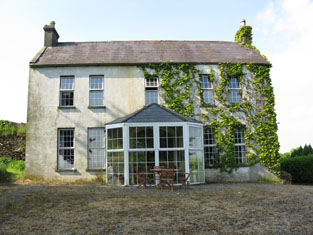
|
| Raleigh | In 1837 Raleagh was the residence of W. Minhear. James Minhear was occupying this house in the mid 19th century. He held it from the representatives of - Carleton and it was valued at £20.10 shillings. | |
| Ashgrove | A home of the Ashe family from at least the 1770s this house was held by Richard Ashe from the Court of Chancery at the time of Griffith's Valuation and was valued at £13.10 shillings. He is also recorded as resident in 1814 and 1837. The sale rental of 1850 records that the house had lately been in the possession of Jeremiah Twomey. This house was owned by Captain Thomas Leader in the 1870s. In 1872 Robert Warren, a younger brother of Sir Augustus Warren, married Blanche Louise, daughter of Captain Leader. Robert Warren, with an address at Ashgrove, Macroom, is also recorded as a county Cork landowner in the 1870s. It is no longer extant though a small number of ruins remain. | |
| Codrum | In 1837 Edward Ashe was occuping a house in the townland of Condrum and this house remained the residence of Edward Ashe until at least the 1870s. In the early 1850s it was valued at £18.15 shillings. It is labelled Codrum West on the 1st edition Ordnance Survey map and as Codrum on the later 25-inch edition of the 1890s. It is still extant. |
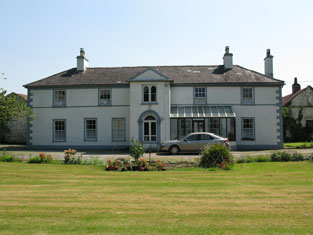
|
| Cooldaniel | This house was the home of Barter esq in the 1770s and 1780s, of Thomas Barter in 1814, of J. Barter in 1837 and of Michael Buckley at the time of Griffith's Valuation who held it from William Gallagy. It was valued at £10. In the 1940s the Irish Tourist Association Survey noted that it had been converted to farm buildings.. | |
| Greenville | The home of a branch of the Swete family from the early 18th century, occupied by Samuel Swete in 1814 and by B. Swete in 1837. Valued at £35 at the time of Griffith's Valuation and held by Benjamin Swete in fee. The house is described as the family residence in the sale rental of 1877 but was held on a short term lease by Frederick Theodore Courtis. It was in ruins by the 1940s as the Irish Tourist Association Survey reported that portion of the ruins were visible on the farm of Mr. Cashman. It also referred to an attack on the house by the Whiteboys in the 1820s which has resulted in several of them being killed. | |
| Ballytrasna | Located on the Earl of Bandon's estate, occupied by the Reverend B. Gash in 1837 and by Thomas Neville in the early 1850s when the house was valued at £10. The location of this house now appears to be under water. | |
| Curraclogh House | Mary Gibson occupied this house at the time of Griffith's Valuation. It was held from Sir Augustus Warren and was valued at £12.10 shillings. This house is no longer extant. | |
| Codrum House | In the 1770s and 1780s Codrum was occupied by Hutchinson esq. It was the residence of John Warren in 1814. There were two houses in this townland at the time of Griffith's Valuation, one occupied by Richard Ashe and the other by Massy H. Warren. The Warren house was known as Codrum House. It was valued at £19. Frederick H. Warren was resident in the 1870s. In 1944 the Irish Tourist Association Survey referred to Codrum as the home of Mrs.S.W. Baldwin and also to the murder of Colonel Hutchinson there. The original house at this site is now a ruin. | |
| Elmglyn | Elmglyn was the residence of T. Gollock in 1837 and of Patrick Daly at the time of Griffith's Valuation. He held the property from the representatives of Thomas Gollock and the buildings were valued at £11. The original house is not extant. | |
| Mount Massy | This house was the residence of Hutchinson esq in the 1770s. Occupied by Hubert [Herbert?] Baldwin in 1814 and by M.H. Massey in 1837. Mount Massy appears to be in use as an auxiliary workhouse at the time of Griffith's Valuation, when the buildings were valued at £50. At the time of the sale in 1861 Mount Massy was in the owner's possession and was held under a fee farm grant from the Earl of Bandon, dated 2 Feb 1859. It was burnt in December 1920 during the War of Independence and is now a ruin. | |
| Lissardagh | The residence of William Baldwin at the time of Griffith's Valuation, held by him in fee and valued at £20. There is still a house extant at this location. |
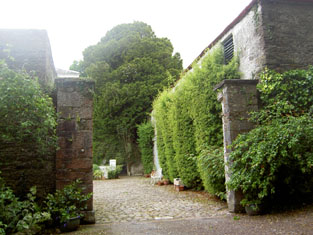
|
| Firville | Leet lists a Robert McCarthy residing at a house called Fir-ville, Macroom in 1814. Lewis refers to Firville, the newly erected mansion of Philip Harding. Henry Harding was the occupier in the early 1850s holding the property from N.D. Murphy. It was valued at £19.10 shillings. The representatives of Henry Harding still owned Firville in the 1870s. Firville passed to the Barry family through the marriage of Ellen Harding, daughter of Henry Harding, and Thomas Barry, son of Michael Barry of Elm Park, Farran, county Cork, land agent to Sir Riggs Falkiner. In 1944 the Irish Tourist Association Survey noted that Firville was then the residence of F. St.Aubyn Horgan, who had connections with the Channel Islands. Firville is still extant and occupied. | |
| Coolcour/Coolcower | Home of the Browne family in the 18th and 19th centuries, occupied by John Browne in 1814, by W.G. Browne in 1837 and still his residence in the 1870s. In the early 1850s the house was valued at £46 and was held in fee. St George G. Browne was resident in 1906. Coolcour was burnt in July 1921, just before the end of the War of Independence, when it was the residence of Richard C. Williams, a hotel owner in Macroom. It was rebuilt and now functions as a guest house, see http://www.coolcowerhouse.ie/ |
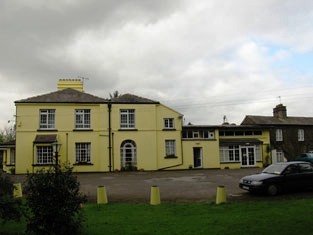
|
| Coolyhane | Lewis refers to Coolehane as recently erected, Richard Ashe was proprietor. Richard Ashe was still the occupier in the early 1850s and held the property from Elizabeth Foote when it was valued at £15.15 shillings. In 1944 the Irish Tourist Association Survey noted that it had formerly belonged to the Ashe family but was then the home of Mr. Purcell, solicitor. It is still extant. | |
| Gurteenroe Cottage | A house valued at £10.15 shillings was occupied by James Welpy on the Hedges estates at Gurteenroe in the early 1850s. In the 1870s and 1880s the home of Charles Raycroft. It is still extant and well-maintained. |

|
| Mount Hedges | Mount Hedges, formerly a family residence, had by the time of Griffith's Valuation become the steward's house, valued at £15. In 1786 Wilson had referred to it as "the beautiful seat of Captain Robert Hedges". There are some ruins remaining at the site. | |
| Macroom Castle | In 1750 Charles Smith recorded Macroom Castle as the residence of Richard Hedges Eyre. Lewis wrote in 1837 that Macroom was "till very lately..the joint property of the Earl of Bandon and Robert Hedges Eyre" but was then the sole property of the latter, who had converted the ancient castle into an elegant modern mansion. Held by the Honourable William Henry White Hedges in fee at the time of Griffith's Valuation, when the buildings were valued at £80. Slater records it as being a seat of Lord Ardilaun in 1894. Macroom Castle was burnt in 1922. In 1944 the Irish Tourist Association Survey gathered a detailed history of the building, noting that "it was burnt in all about five times" in its long history. The impressive gateway is all that remains. |

|
| Rockborough | Rockborough was the home of T. Mitchel Browne in 1837. Situated on the Hedges estate it was occupied by John G. Browne in the early 1850s, when it was valued at £25. In 1944 the Irish Tourist Association Survey noted that it had formerly belonged to the Brownes but was then the home of the Twomey family. This property is still extant. | |
| Sandy Hill | Home of the Reverend John Orpin in 1814, by 1837 this house was the residence of Thomas S. Coppinger and remained a Coppinger home for the rest of the 19th century. Located on the Hedges White estate it was valued at £9 in the 1850s. In 1944 the Irish Tourist Association Survey reported that it was the residence of Timothy Lucey, solicitor. There is still an extant house at the site. | |
| Grange (Athnowen) | Smith records Mr Onesiphorus Phaire as resident at Grange, Ovens, in 1750. Wilson, writing in 1786, refers to it as the seat of Mr. Whyte. This house was the home of the Hawkes family in the 19th century, occupied by J. Hawkes in 1814 and 1837 and by John Hawkes in the early 1850s, when the house was valued at £12 and held from Sir John Walsh. A house is still extant at the site. | |
| Aghavrin House | This house was the home of the Crooke family for much of the 19th century, occupied in 1837 by Captain T. E. Crooke and at the time of Griffith's Valuation by William Crooke. The house was valued at £26 and held from John B. Gumbleton. The Irish Tourist Association Survey of the 1940s refers to it as the residence of Mrs. Scott, nee Crooke, by whose family the house was built. It also rather quaintly notes that “During the troubles of 1919-1921, the IRA often billeted themselves on the premises without any special invitation from the owner”. Aghavrin is still extant and occupied. |
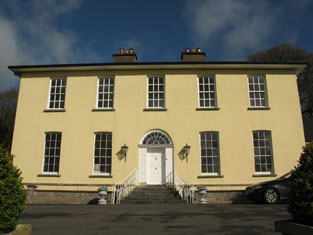
|
| Coolalta | This house was the residence of the Reverend Pierce Green PP in 1837. It is named Coolalta Cottage on the first Ordnance Survey map and Coolalta on the later 25-inch edition of the 1890s. Occupied by Frederick Arden, valued at £13+ and held from Thomas Crooke at the time of Griffith's Valuation. A house is still extant at the site. | |
| Oak Grove | Home of the Bowen family, occupied by Mrs Bowen in 1814, by J. Bowen in 1837 and by John Bowen in the early 1850s when it was valued at £28 and held in fee. The National Inventory of Architectural Heritage states that parts of the property were rebuilt c.1930 following the burning of the original house in June 1920. In the early 1940s the Irish Tourist Authority noted that it had been lived in by some years by a well-known actress, "Miss Lilly-Elsie" who was married to Major Ian Bullough. It is now known as Oakpark House. |
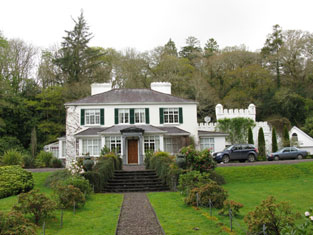
|
| Aglish | The Hingstons were resident at Aglish from the early 18th century. At the time of Griffith's Valuation James Hingston owned a house valued at £21 in fee. An "old mansion house" is marked on the first Ordnance Survey map at the Grid Reference W469715. The current Aglish House was built after that and appears on the 25-inch map of the 1890s. It is still extant. | |
| Fort William [Kinalea] | Charles L. Bernard held Fort William in fee at the time of Griffith's Valuation, when it was valued at almost £9. Lewis refers to it as the seat of William Penrose in 1837. Buildings remain at the site. | |
| Upton | Reverend Somers Payne held this property in fee at the time of Griffith's Valuation, when it was valued at £45. Lewis names the seat of Reverend Payne as "Upton" in 1837. Noted by Leet as the seat of W.L. Beaufort in 1814. James Welply was resident in the 1870s. In 1942 the Irish Tourist Association survey noted that a sister of the Sheares brothers, executed as United Irishmen, was married into the Payne family and that the brothers were in the habit of visiting Upton. This property is still extant and run as a facility providing nursing care services. |
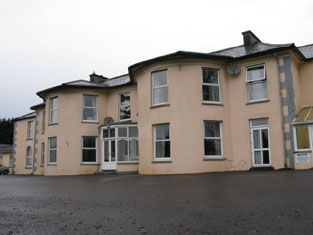
|
| Garryhankardmore | Mary Nash and Howard Wiseman were leasing this property to Robert Biggs at the time of Griffith's Valuation when it was valued at £35. In 1837 Lewis referred to as the seat of T. Biggs. There are still extant buildings at the site. | |
| Farran | This house was owned by Samuel Penrose at the time of Griffith's Valuation when it was valued at £24. It was also occupied by him in 1837. In 1868 Farran was bought by William Clarke and three generations of the Clarke family lived at Farran until 1970. In 1906 the buildings were valued at £226 and Thomas Clarke was the occupier. The Irish Tourist Association Survey in the 1940s describes it as "the splendid residence of Captain Clarke, living in the Channel Islands but occupied by his relatives". The present owners offer self catering accommodation for groups. see http://www.farranhouse.com/history.htm |

|
| Shandangan House | Smith records Christopher Earbury as resident at Shandangan in 1750. Devonsher Esq was the proprietor of Shandangan in the 1770s and 1780s. A Mr Timothy Mahony was living at Shandangan, Macroom in 1814. Lewis records S. Penrose as the proprietor of Shandangan (parish of Kilmurry) in 1837 and Samuel Penrose was still occupying the house at the time of Griffith's Valuation. He held it in fee and it was valued at £13.10 shillings. | |
| Old Fort | A house occupied by Henry Good at the time of Griffith's Valuation, held from Samuel Penrose and valued at £18.10 shillings. | |
| Forest House | In 1750 William Spread was living at Forest and in the 1770s and 1780s Spread Esq is recorded as resident at Forest. In 1814 Leet records this "seat" as unoccupied. T. Gollock was resident in 1837 and Thomas Gollock held the property in fee at the time of Griffith's Valuation when it was valued at £38. Slater records it as the seat of Rev. T.H. Gollock in 1894. Forest was burnt in July 1921 just before the end of the War of Independence when it was the property of James Gollock and occupied by Lt. Col. Isaac Burns-Ludlow. The Irish Tourist Association survey refers to this in the 1940s as it having been burnt "as a military precaution". It is no longer extant. | |
| Upper Forest | A house valued at £20.10 shillings at the time of Griffith's Valuation, held by John Hassett from Thomas Gollock. It is still extant and occupied. |
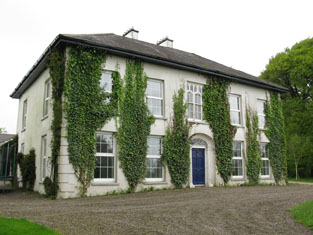
|
| Leemount | Leemount was the home of Thomas Coppinger in 1814 and of Thomas Gollock in 1837. In the early 1850s this house was occupied by Thomas H. Broderick, valued at £30, and held from Thomas Gollock. In 1894 Slater refers to it as the residence of Albert Beamish. Leemount is recorded as one of the residences of John Lindsay, eldest son of George Crawford Lindsay of Moorlands, county Down in Walfords (1910). This original house was burnt in March 1921 during the War of Independence when it was the residence of Maria Lindsay, later executed as an informer by the IRA. It was replaced by the existing house. |

|
| Leades House | "Burke's Irish Family Records" states that the Woodleys bought Leades House in the mid 17th century. F. Woodley occupied the house in 1837 and Francis G. Woodley in the early 1850s. He held the property from the representatives of William Woodley and Winthrop Sealy. Slater notes it as the seat of Captain Woodley in 1894 and the Woodley family still occupied this house in the early 20th century. A house is still extant at the site. |
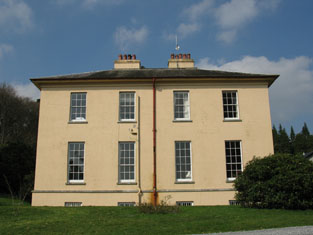
|
| Nadrid | A house occupied at the beginning of the 19th century by Joseph Woodley, who married Anne Baldwin in 1799 but died a few years later. By 1814 Samuel Galway was residing at Nadrid. In 1837 Henry O'Callaghan was the occupier and he was still resident at the time of Griffith's Valuation. He held the house valued at £42 from the representatives of Abraham Cross. The Irish Tourist Association survey of the 1940s refers to Nadrid as the residence of Captain Matthews. A house still remains at the site. |

|
| Rosemount | A house occupied by S. Penrose in 1814, by W. Hawkes in 1837 and Joseph R. Harding at the time of Griffith's Valuation. He held the property from John L. Westropp and the buildings were valued at £25. There is still an extant house at the site. |
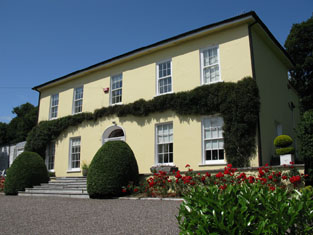
|
| Upper Forest | Occupied by John Hassett at the time of Griffith's Valuation and held from Thomas Gollock. The house was valued at £20+. The representatives of John Hassett still lived at Forest in the 1870s. | |
| Kilcrea House | In 1750 Smith wrote that Kilcrea was formerly the seat of the Earls of Clancarty, purchased by Captain Hedges from the Trustees of the Hollow Blade Company. In 1786 Wilson mentions the ruins of the castle and abbey of Kilcrea, near to which was a house named Snugborough, the residence of Mr. Keeffe. At the time of Griffith's Valuation Robert Gibbons was the occupier of Kilcrea House. He held the house valued at £20 from John Hawkes [who was leasing from Richard T. Rye]. This house is now a ruin. In March 1851 and July 1853 the estate of William Edward Ellis at Kilcrea, Desart, including Kilcrea House and 422 acres was advertised for sale. It was held on a lease dated 1740 Jonathan Ashe to Jeremiah Sullivan. William E. Ellis was the tenant of the house in 1853. William Sullivan Ellis of Kilcrea was issued with a certificate with respect to the killing of game in 1799 (see "The New Cork Evening Post" 24 March 1800). | |
| Derry | The home of the Gibbs family in the 18th and early 19th centuries. It was occupied by J.B. Gibbs in 1837 and by John Hassett in the early 1850s, when the buildings were valued at £11 and held from the Reverend Robert Gibbs. | |
| Nettleville | The home of the Nettles family in the 19th century, valued at £35 in the 1850s. Occupied by the Reverend Basil Orpin in 1814. This house was still in Nettles occupation in 1906 but is now a ruin. |

|
| Clonmoyle | In 1837 this house was the home of Charles Colthurst, a younger son of John Colthurst and his wife, Jane Bowen. At the time of Griffith's Valuation Jonathon Bruce was the occupier. He held the house valued at £35 from Charles Colthurst. Henry Leader of Clonmoyle, Coachford, owned 2,418 acres in county Cork in the 1870s. The Irish Tourist Association survey of the early 1940s mentions that it was the residence of Mrs.Young, the owner of Clonmoyle Flour Mills and that it had previously been the home of Harry Leader. It is now a ruin. | |
| Dripsey Castle | This house was the home of the descendants of John Colthurst and his wife Jane Bowen from the late 18th to the early 20th century. It is still extant though it was damaged by fire in June 1920. The Irish Tourist Association survey in the early 1940s recounts the boycotting of the family following the Sheehy-Skeffington murder in 1916 and their subsequent departure to live in England. In the early 1940s it was the property of John O'Shaughnessy who also owned Dripsey Woollen Mills. In 2014 it was offered for sale. |

|
| Beechmount | Occupied by Dr Godfrey in 1837 and by Thomas Batten who held the property from Henry Lindsey in the early 1850s. A house is still extant at the site. | |
| Kilberrihert | A house which was the residence of R.E. Crooke in 1837 but was unoccupied in the early 1850s. At that time it was valued at £20+ and Thomas E. Crooke was the lessor. A building is extant at the site. | |
| Mountrivers | The proprietors of this house were John Whiting in 1750, George Whiting in 1814 and N. Whiting in 1837. By the time of Griffith's Valuation Denis Leary was the occupier, holding the property valued at £13+ from the representatives of Nicholas Whiting. The Irish Tourist Authority survey in the early 1940s reported that it was then owned by a farming family named O'Rourke. A house is still extant at the site. | |
| Peake House | Henry Lindsey was resident at Peake in 1814 and his descendant, Catherine Lindsay, still occupied the house in the early 1850s. She held it from Daniel O'Connor and it was valued at £16. A member of the Lindsay family was still residing at Peake in the mid 1870s. A house is still extant at this site. | |
| Hayfield | A house, offices and mill valued at £22+ was occupied by Henry Lindsey at the time of Griffith's Valuation and held from Charles Connell. In the 1940s the Irish Tourist Association survey noted that it was then occupied by the Carroll family and had been built "about 150 years ago". The original house is not extant now. | |
| Meeshal House | In 1837 Lewis describes the work done at Myshell by Dr Barter “whose demesne of 200 acres, formerly an unprofitable waste, has, since 1826, been reclaimed and brought into a state of high cultivation.” The house valued at £36 was occupied by Thomas Kenyon at the time of Griffith's Valuation and held from Henry Lindsey. In the 1940s the Irish Tourist Association survey noted that it was "formerly a Hydro before the enterprise transferred to St. Ann’s in Blarney". The National Inventory of Architectural Heritage suggests that the current house incorporates portions of the original. |

|
| Killinardrish House | Lewis describes this house as a "elegant Italian lodge lately built by R. J. O’Donoghue". It was valued at £38 and held from Sir Augustus Warren. In 1944 the Irish Tourist Association Survey noted that it was the residence of Mr. O'Donovan, manager of the creamery at Lissarda. Killinadrish is still extant. There was also a steward's house in this townland occupied by members of the Crooke family. |
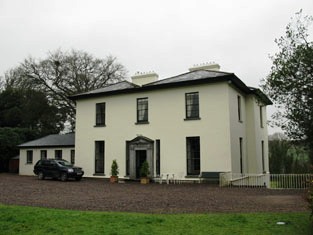
|
| Green Lodge | Occupied by R. Coppinger in 1837 and by Anne Coppinger at the time of Griffith's Valuation and held by her in fee. The buildings were valued at £15.10 shillings. The sale rental of 1868 records the leasing of this property by George Lombard to Thomas Stephen Coppinger in 1789 for 999 years and the leasing of the Coppinger interest to Charles Manning in 1860 for 600 years. The Irish Tourist Association survey notes that it was built by the Coppinger family, "one of whose members turned Protestant to save the estate". It is no longer extant. | |
| Derreen | A Crooke family home in the 19th century, occupied by William Crooke in the early 1850s and held from William Furlong. The buildings were valued at £12.15 shillings. [This may possibly be the house known as Broomhill, a residence of the Cross family. Epenetus Cross of Broomhill made his will in 1776, see http://www.radleysofcork.bigpondhosting.com/My_Homepage_Files/Page2.html].) This house was offered for sale in 2010. |
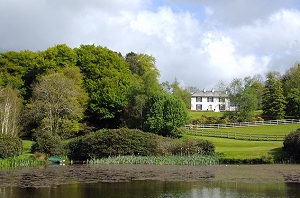
|
| Shandy Hall | The Crosses were living at Shandy from at least the late 18th century. Lewis records P. Cross as the proprietor of Shandy Hall in 1837 and Philip Cross held the house valued at £33 and 106 acres from Colonel [Mair] at the time of Griffith's Valuation. Philip Cross of Shandy Hall is recorded in 1876. The Irish Tourist Association noted that a stone inscribed with the date 1758 existed at the house and also referred to its being "the home of Phillip Cross who murdered his wife and was hanged in Cork Jail" Shandy Hall is still extant and occupied. |
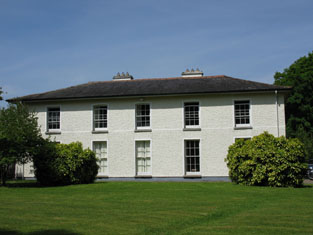
|
| Nadrid | Daniel Connor held a house in the townland of Nadrid valued at £31+ from the representatives of Abraham Cross. This may be the house known as Riversdale marked on the first Ordnance Map. In 1894 Slater refers to Nadrid House as the residence of William O'Sullivan Galgey. A house still exists at the site. | |
| Classas | A house occupied by H. Minhear in 1837 and by Lewis Gollock at the time of Griffith's Valuation when it was valued at £26 and held from William Crooke. In 1894 Slater notes it as the seat of A. McCall. In the 1940s the Irish Tourist Association survey noted that it was then being run by Mrs. Agnes Leader as a guesthouse "for relatives". It is still extant and occupied. |
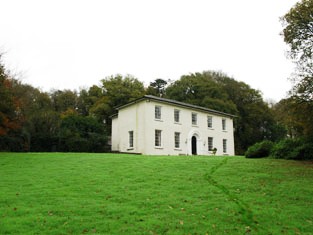
|
| Old Town | S. Crooke was residing at Old Town in 1837 and Simon D. Crooke in the early 1850s when the house was valued at £14.10 shillings and held from William Furlong. It is no longer extant. | |
| Rockgrove | A house valued at £18.10 shillings was held by John Good from John Carney at Rockgrove in the early 1850s. John Good is also recorded as resident in this house by Lewis in 1837. | |
| Rockville | The family home of the Radley family in the 18th and early 19th century. Occupied by Cornelius Ahern and held from the representatives of Henry Longfield at the time of Griffith's Valuation. The buildings were valued at £9.15 shillings. | |
| Cottage | Originally a Vize home, later occupied by the Pyne family, J. Pyne was in residence in 1814 and 1837 and the house appears to be unoccupied at the time of Griffith's Valuation, Reverend John Lawless Pine was the immediate lessor. It was valued at £17.15 shillings. | |
| Elm Park | Garyhasty was described by Smith in 1750 as the "pleasant country house" of Mr Riggs Faulkner. I A house located on the Riggs Falkiner estate, Wilson notes it as the seat of Rev. Mr. Kenney in 1786. It was occupied by Valentine Barry in 1837 and by Thomas Barry at the time of Griffith's Valuation and valued at £36. Home of Richard Ashe Orpen in the 1870s. Elm Park is still extant and occupied. |
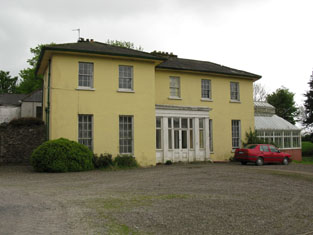
|
| Ryecourt | Seat of the Rye family in the 18th, 19th and 20th centuries, In 1786 Wilson refers to it as the seat of Colonel Rye. Lewis writes in 1837 that “the plantations around Rye Court are very extensive and beautiful”. The buildings were valued at £66 in the early 1850s. Ryecourt was burnt in June 1921 during the War of Independence. The family built a smaller house in the garden and continued in residence at Ryecourt into the 1970s. Ryecourt House was demolished but some of the farmyard complex remains. |

|
| Warren's Court | Kilbarry was bought by the Warrens in the late 17th century. The house Warren's Court was built in the 18th century and was the main seat of this family in the 18th and 19th centuries. In 1750 Smith refers to Kilbarry the "handsome house" of Robert Warren. Wilson notes it as "the fine seat of Thomas Warren" in 1786. In 1894 Slater refers to it as the seat of Sir A. Warren. In 1906 it was valued at £66 and occupied by Sir Augustus Riversdale Warren.. It was burnt in June 1921 during the War of Independence when it was the residence of Sir Augustus D. Warren. The original house is no longer extant. In the 1940s the Irish Tourist Association Survey reported that a modern two-storey house had been constructed nearby. | |
| Crookstown | Smith records Mr Crook of Crookstown in 1751. The mother of Robert Warren, 1st Baronet, was Anne Crooke and this house may have got its name from her. It was the home of a branch of the Warren family from the late 18th century, occupied by the Reverend E. W. Warren in 1814, by the Reverend R. Warren in 1837 and in the early 1850s. The Reverend Robert Warren held the property in fee and the buildings were valued at £48. It was burnt in June 1921 during the War of Independence when it was the residence of Robert Warren. It is still extant and occupied. |
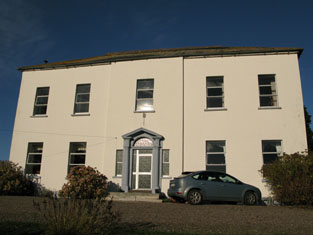
|
| Warrensgrove | This house was the home of John Borlase Warren who succeeded his brother Sir Augustus Warren as 4th Baronet. He is recorded as being resident in 1837 and at the time of Griffith's Valuation when he held the property from Sir A. Warren. The buildings were valued at £48. In the 1940s the Irish Tourist Association Survey noted that Warrensgrove had been burnt in 1921. The original house is now a ruin but buildings adjacent have been redeveloped as a country house. In 2014, the property, including the ruin, was offered for sale. |

|
| Cronody | In the mid 18th century Smith refers to the seat and improvements of Mr Cross at Coronody. At the time of Griffith's Valuation James Cross occupied a house valued at £10.10 shillings which he held from Viscount Midleton and John H. Colthurst. This would appear to be the house marked Crondybeg on the first Ordnance Survey map. Cronodymore was in ruins. Gillman writes that Cronodymore was inherited from Richard Hawes by the late 17th century marriage of Philip Cross to Mary Ellard, step daughter of Richard Hawes. A house and farm building are still extant at the site. | |
| Ellen Ville | This appears to be the house known as Broomhill which was a Radley residence. The house is named Ellen Ville on the first Ordnance Survey map. At the time of Griffith's Valuation Dr Thomas Godfrey was occupying Ellen Ville, valued at £14.15 shillings and held from William Furlong. | |
| Aherla Cottage | A residence valued at £11 and held by William Good in fee at the time of Griffith's Valuation. | |
| Lirias | Mrs Ellard was resident at this house in 1837 and in the early 1850s it was occupied by Benjamin Barter who held it from Sophia Ellard. It was valued at £20. The house shown as Lirias on the 1st edition Ordnance Survey map is not visible on the later 25-inch map of the 1890s though a nearby group of buildings has the same name. Some of these now form part of a farmyard complex. | |
| Aherla | Occupied by the Reverend John Madras at the time of Griffith's Valuation and held from Richard Goode, the buildings were valued at £11.10 shillings. | |
| Bellmount | Bellmount, Innishannon was the residence of the Reverend James Crowley in 1814. T. Herrick was the proprietor of Bellmount in 1837 along with a large flour mill. The mill and house were in the possession of Patrick Howard at the time of Griffith's Valuation and held from John E. Herrick. The house was valued at £18 and the mill at £65. The mill building, though now disused, is still extant. |
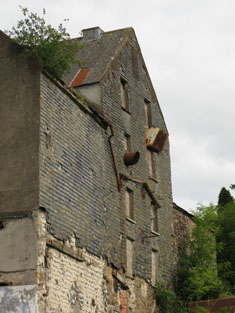
|
| Shandangan East | A house occupied by Patrick Hassett at the time of Griffith's Valuation held from Samuel Penrose and valued at £18.10 shillings. This property is labeled Larch Hill House on the 25-inch Ordnance Survey Map of the 1890s. It is still extant and occupied. |
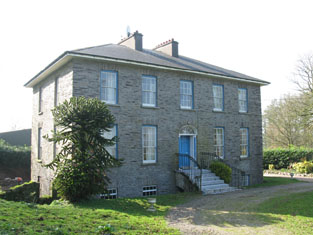
|
| Springmount | In 1837 and at the time of Griffith's Valuation this property was occupied by Samuel McCarthy. Valued at £19.10 shillings it was held from Lady Carbery's estate. There is still an extant house at the site. | |
| Clashanure | Home of a number of generations of the Allen family in the 18th and 19th centuries. Occupied by the representatives of Kyrle Allen at the time of Griffith's Valuation and held from Robert Meade. The buildings were valued at £15 and the Allens also had a mill valued at £13. Still extant and occupied. |
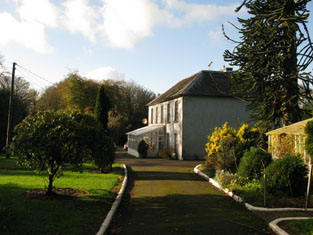
|
| Classes | Classes was occupied by William O'Callaghan in the early 1850s and held from John Stevely. The buildings were valued at £11. There are two houses at Classes on the 1st edition Ordnance Survey map. Classes House is located at W562705 while the second is labelled Classes House East and located at the site of the current Classes House which bears a date label of 1823. |
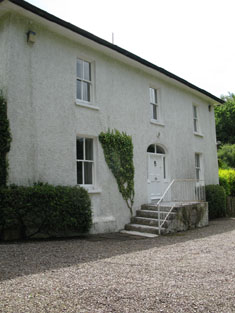
|
| Lisheens | The residence of Richard Donovan at the time of Griffith's Valuation, held from the representatives of John Stevely and valued at £16. | |
| Oriel House | Built in the first decade of the 19th century by the Board of Ordnance. The house was occupied by Charles Wilkes, the superintendant of the gunpowder mills until purchased by the Tobins of Liverpool in the mid 1830s. Mrs Tobin was a painter and their residence became known as Oriel House under Tobin ownership. The house has been a hotel since 1983. |

|
| Coolyduff House | At the time of Griffith's Valuation this house valued at £16 was occupied by Alfred Parnell and held from Richard Beamish. Labelled as Coolyduff House on the 25-inch Ordnance Survey map of the 1890s. There is still an extant house at the site. | |
| St Anne's Hill | Richard Barter occupied a house valued at £55 in the townland of Kilnamucky at the time of Griffith's Valuation. St Anne's Hill is marked on the first Ordnance Survey map in this townland. By the 1890s this property had become absorbed into a complex of buildings labelled Hydropathic Establishment. The National Inventory of Architectural Heritage notes that most of the complex is now in ruins though Maranatha House survives as a residence. |

|
| Ardrum | The seat of the Colthurst family, baronets, valued at £85 in the mid 19th century. The Colthursts moved from here to Blarney in the 1870s. However Sir George St John Colthurst is still given as the occupier in 1906 when the house was valued at £45. In 1944 the Irish Tourist Association survey noted it as originally the seat of the Colthursts and still owned by the family. The house is now demolished. | |
| Surmount/Sirmount | Sirmount was the residence of Emmanuel Moor in 1750. In 1786 Wilson refers to it as the seat of Mr. Hawkes. This house was occupied by G. Hawkes in 1837 and by Quaile Hawkes in the early 1850s. The property was held from Lady Carbery. The buildings were valued at £8.15 shillings. It is no longer extant. | |
| Bride View | Occupied by Samuel Hawkes and held from the representatives of William Hawkes at the time of Griffith's Valuation. The buildings were valued at £13.10 shillings. The property at this location is labelled Knockanemore House on the 25-inch Ordnance Survey map of the 1890s. There is still an extant house at the site. | |
| Woodview | A house named Wood-view near Cork was occupied by Thomas Cuthbert in 1814. The Reverend William Spedding occupied Woodview in the early 1850s. He held it from Sir George Colthurst and the buildings were valued at £12. A house is still extant at the site. | |
| Inishleena | Located on the Devonshire estate, Inishlenna Abbey was occupied by Cross Fitzgibbon at the time of Griffith's Valuation and in the 1870s. The buildings were valued at £10. The location of the Abbey is now under water as part of a reservoir. | |
| Cloghroe House | In 1786 Wilson refers to Cloghroe as the seat of Mr. Capel. In the late 18th century this house passed by marriage from the Capel family to the Fitzgerald family. J. C. Fitzgerald was resident at Cloghroe in 1814. The house, valued at £28, was occupied by Thomas Keogh in the early 1850s and held from Thomas Fitzgerald. In 1944 the Irish Tourist Association Survey referred to it as the residence of Major O'Mahony of Blarney Mills. A house is still extant at Cloghroe. | |
| Inchbeg | Located on the Fitzgerald estate, this house was occupied by Henry Young, at the time of Griffith's Valuation. The buildings were valued at £11.15 shillings and he also held a mlll valued at £84. A house is still extant at the site. |
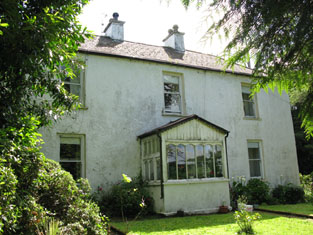
|
| Firmount | A Townsend family home, occupied by Horace Townsend in 1837 and by William Coghlan at the time of Griffith's Valuation. It was then valued at £14.10 shillings and was held from Horatio Townsend. The sale rental of 1877 records a fee farm grant of Firmount from John Crewe Chetwood Townsend to Arthur Chute dated 1871 and a fee farm grant from Arthur Chute to J.C.C. Townsend executed the following year. A house is still extant at the site. | |
| Knockane | A house valued at £14.10 shillings in the early 1850s when it was occupied by Henry Ruby and held from Samuel P. Townsend. The original house is no longer extant. | |
| Garraun | George C. Stawell held this property from Sir George Colthurst at the time of Griffith's Valuation. The buildings were valued at £7.10 shillings. This house was still occupied by the Stawells in the 1870s. A house and farm are still extant at the site. | |
| Castlenalact | William Keyes held this property from the Devonshire estate in 1851 when it was valued at £35. This house is still extant. |

|
| Finnis | Thomas Gash was leasing offices from the Devonshire estate in 1851 when the buildings were valued at £11. A house and extensive farm buildings exist at the site now. | |
| Kilmore House (Bandon) | Michael Curtin was leasing this property from the Devonshire estate in 1851 when it was valued at almost £19. Noted by Lewis, in 1837, and Leet, in 1814, as the seat of William Popham. Local tradition associates this house with Maj. Daniel O'Mahony, participant in the Battle of Cremona, 1702. The original house is not extant. | |
| Ballinacurra House (Bandon) | In1851 this house was being leased by Joseph Nash from the Devonshire estate, when it had a valuation of £14. There is still an extant house at the site. | |
| Kilnagnady House | Leased by John Popham from the Devonshire estate in 1851 when it was valued at £10. There is still an extant house at this site. | |
| Mallowgaton | Leased by Robert Foulkes from the Devonshire estate in 1851 when it was valued at £11 10s. Labelled Mallowgaton on the 1st edition Ordnance Survey map and as Mallowgaton House on the 25-inch edition of the 1890s. It is still extant. | |
| Woodfort (Bandon) | John Ottley was leasing Woodford from the Alcock family in 1851 when it was valued at £25. It is still extant. | |
| Roughgrove | Leased by Benjamin Hosford from the Alcock estate at the time of Grifith's Valuation, when it was valued at £30. It was included in the sale of Hosford's estate in the Encumbered Estates Court in January 1851, when it was noted that it was "a handsome mansion house, occupied by John Ottley who had spent considerable sums on improvement". Both Lewis, in 1837, and Leet, in 1814, refer to it as the seat of Maskelyne Alcock. This is possibly also the property noted by Wilson in 1786 as Ballygarvy. It is no longer extant. | |
| Raheen House (Kinalmeaky) | Held by Augustus Warren but unoccupied at the time of Griffith's Valuation,when it was valued at £9. Noted by Leet as the property of William Warren in 1814. The original house is no longer extant. | |
| Mount Pleasant | Held in fee by Henry Baldwin in 1851 when it was valued at £30. Lewis described it in 1837 as " a handsome mansion on a commanding eminence in a highly improved demesne". Also the seat of Henry Baldwin in 1814 and referred to by Wilson in 1786 as "Curravordrie, the fine seat of Walter Baldwin". In 1943 the Irish Tourist Association survey noted that it was owned by the Russell family but that it was possible some of the building would have to be demolished. The house is still extant but in poor repair. |

|
| Mount Pleasant Cottage | Leased by Mathew Belsange from the Baldwin estate in 1851 when it was valued at £10 10s. This property no longer exists. | |
| Farranhavane House | Leased by John Smith Wood from the representatives of Maskelyne Alcock in 1851 when it had a valuation of £10. It is still extant and part of a large farming enterprise. | |
| Mossgrove | Held in fee by Samuel Baldwin in 1851 when it had a valuation of £20. Also noted as his residence by Lewis in 1837. Mossgrove seems to have pre-dated Mount Pleasant as the Baldwin residence in this area. There is still an extant house at this site. | |
| Mossgrove Lower | Mossgrove Lower appears on the 1st edition Ordnance Survey map close to the site of a fortified house dating from the early modern period which is recorded as "in ruins" by the 1830s. In 1851 Henry Baldwin was leasing the property here to Thomas Barter when it was valued at £9. Leet notes a property at Mossgrove as the residence of Robert Popham in 1814. It was no longer extant by the publication of the 25-inch map of the 1890s, | |
| Scartnamuck House | Benjamin Popham was leasing this house from the Devonshire estate at the time of Griffith's Valuation, when it was valued at £25. It is also noted by Lewis as his residence in 1837. The house is still extant. |

|
| Old Park House (Templemartin) | Leased by Benjamin Hosford from the Devonshire estate at the time of Griffith's Valuation, when it was valued at £13. Lewis refers to Old Park as the seat of H.Gillman in 1837. A house still exists at the site. | |
| Garranes (Templemartin) | In 1837 Lewis describes Garranes as "a newly erected and handsome house, near the old family mansion, the residence of J. Splaine". At the time of Griffith's Valuation, it was held by James Splaine from the Duke of Devonshire's estate and valued at £28. It is still extant. |
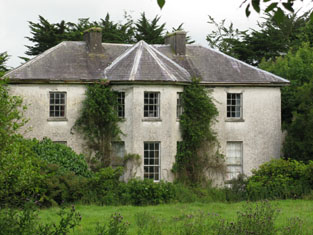
|
| Moneen | Richard Splaine was leasing this property in 1851 from the Baldwin estate when it was valued at £18. | |
| Lisnagat | James Dawson was leasing a property valued at £10 from the representatives of James Baldwin at Lisnagat in 1851. It is still extant part of an extensive farm complex. | |
| Lisnagat Mills | John Wheeler held this property from the Baldwin estate at the time of Griffith's Valuation when it was valued at £26+. It is labelled Lisnagat cotton mill on the 1st edition Ordnance Survey map but does not feature on the 25-inch map of the 1890s. | |
| Garranes House | Leased by James Splaine from the Devonshire estate in 1851 when it was valued at £28. Described by Lewis in 1837 as a "newly erected and handsome house, near the old family mansion, the residence of J. Splaine". |

|
| Hanover Hall | Occupied by J. Bowen in 1837 and by Robert Harnett at the time of Griffith's Valuation, when the house valued at £10 was held from Jonas Morris. A large farm exists at the site now. | |
| Deeshart | Denis Fielding held a house, office and mills valued at £28 from John H. Colthurst at the time of Griffith's Valuation. This may be the premises labelled "Carding Mill" on the 1st edition Ordnance Survey map and as "Dripsey Woollen Mills" on the 25-inch edition of the 1890s. Industrial buildings still exist at the site. | |
| Kilcullen | Kilcullen House is marked on the first Ordnance Survey map. In the mid 19th century the house valued at £8.15 shillings was occupied by Jeremiah Lynch and held from George Vincent. The Lynchs were still resident in the 1870s. | |
| Kilcrea House Upper | At the time of Griffith's Valuation, Corliss Hawkes held a house in Kilcrea townland valued at almost £10. This property is labelled Kilcrea House (Upper) on both the 1st and 25-inch edition Ordnance Survey Maps. A building still exists at the site. | |
| Castle View | A house located just east of the present day reservoir south of Macroom. Lewis records P. Ronayne as resident at Castleview in 1837. Patrick Ronane was the occupier of a house valued at £11 in this townland in the mid 19th century. The sale rental of April 1861 describes the house as "commodious" with a walled in garden. It was held on a lease from Michael Cox to John Ronayne as trustee for Thomas Browne dated 1800. Buildings are still located at this site. | |
| Belrose | A house which, according to the National Inventory of Architectural Heritage, was built c.1860. The land was owned by John Hawkes at the time of Griffith's Valuation. It is still extant and occupied. |
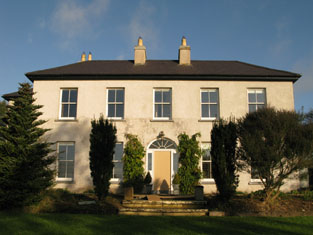
|
| Dripsey Lodge | At the time of Griffith's Valuation this property was occupied by Alfred Greer, leasing from Sir William Magny. The house was valued at £26 while the adjacent paper mills had a valuation of £120. It is named as Dripsey House on the 25-inch Ordnance Survey map of the 1890s. The house is no longer extant. | |
| St. Olan's | Rev. William Welland was leasing the property from William Crooke at the time of Griffith's Valuation when it was valued at over £20. It is labelled St. Olan's Rectory on the First Edition Ordnance Survey map and as St.Olan's on the 25-inch edition of the 1890s. In the early 1940s the Irish Tourist Association survey reported that it was occupied by Mr. Devlin, area engineer. The house is still extant and occupied. | |
| Ballincollig | In 1786, Wilson mentions a seat of Mr.Lloyd at Ballincollig, "near the ruins of the castle". By the time of Griffith's Valuation, this area appears to have been in the possession of Thomas Tobin and the house may have been that leased by Rev. David Horgan, when the buildings were valued at £14. A substantial farm still exists at this site. | |
| Greenfield (Ballincollig) | In 1786, Wilson refers to Greenfield, near Ballincollig, as the seat of Mr. Carleton with another house, the seat of Mr. Wetheral, opposite. Greenfield House is labelled on the 1st edition Ordnance Survey map but is not shown on the 25-inch edition of the 1890s. Greenfield Upper, across the road, is shown on both maps. At the time of Griffith's Valuation this townland was in the possession of Francis Carleton. Greenfield House was valued at £11 while the second house in the townland was valued at almost £10. Neither were occupied. A building is still extant at the Greenfield Upper site though extensive modern housing has been built in the surrounding area. | |
| Clontead More House | At the time of Griffith's Valuation, Herbert Gillman was leasing a property valued at £14 from Edward Murphy. This house was built after the publication of the 1st edition Ordnance Survey map. The Irish Tourist Association survey refers to "Clontead" as the former residence of the historian, Herbert Webb Gillman,(1832-1898). It is still extant and seems to have become known as Clontead More House. |

|

